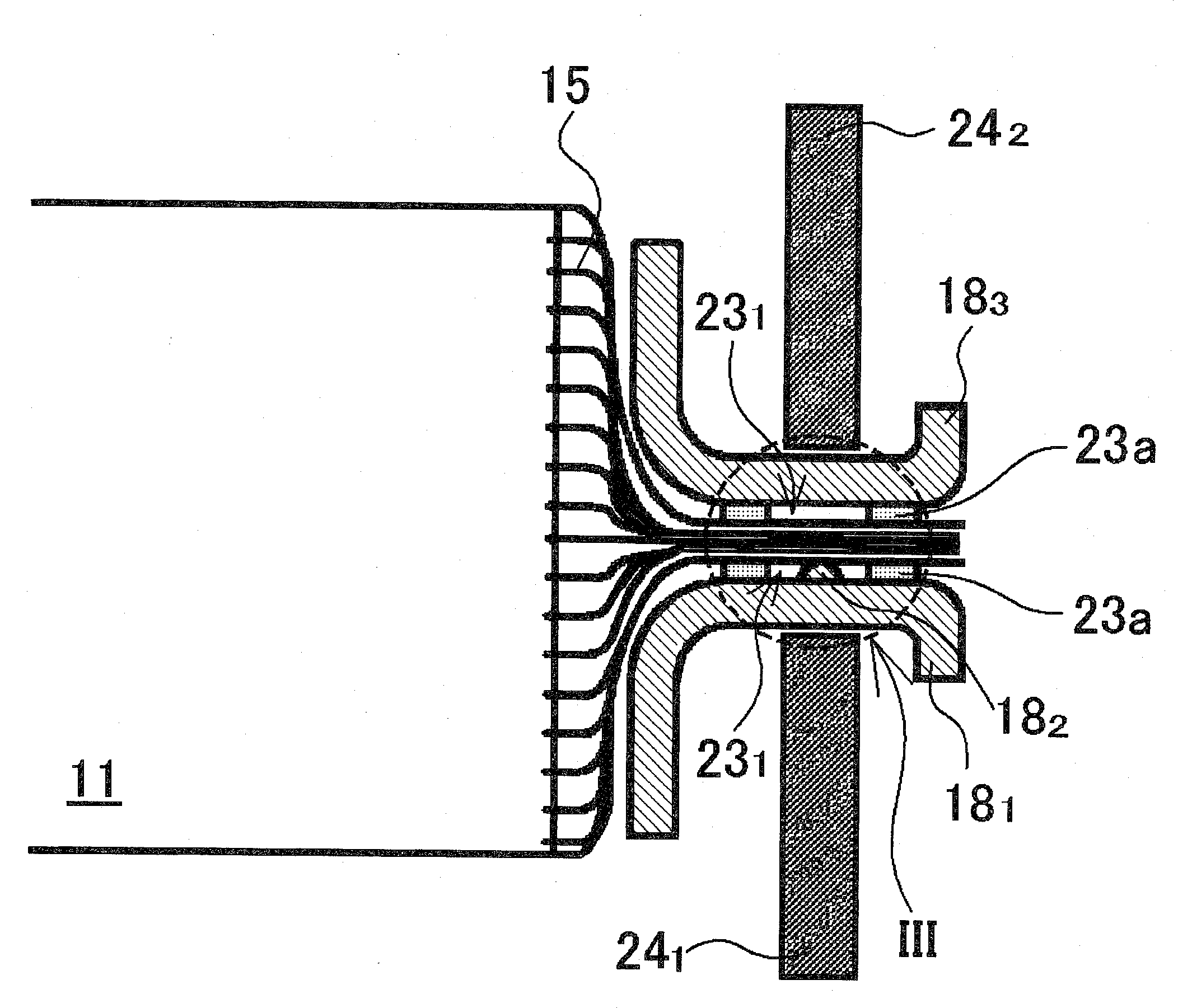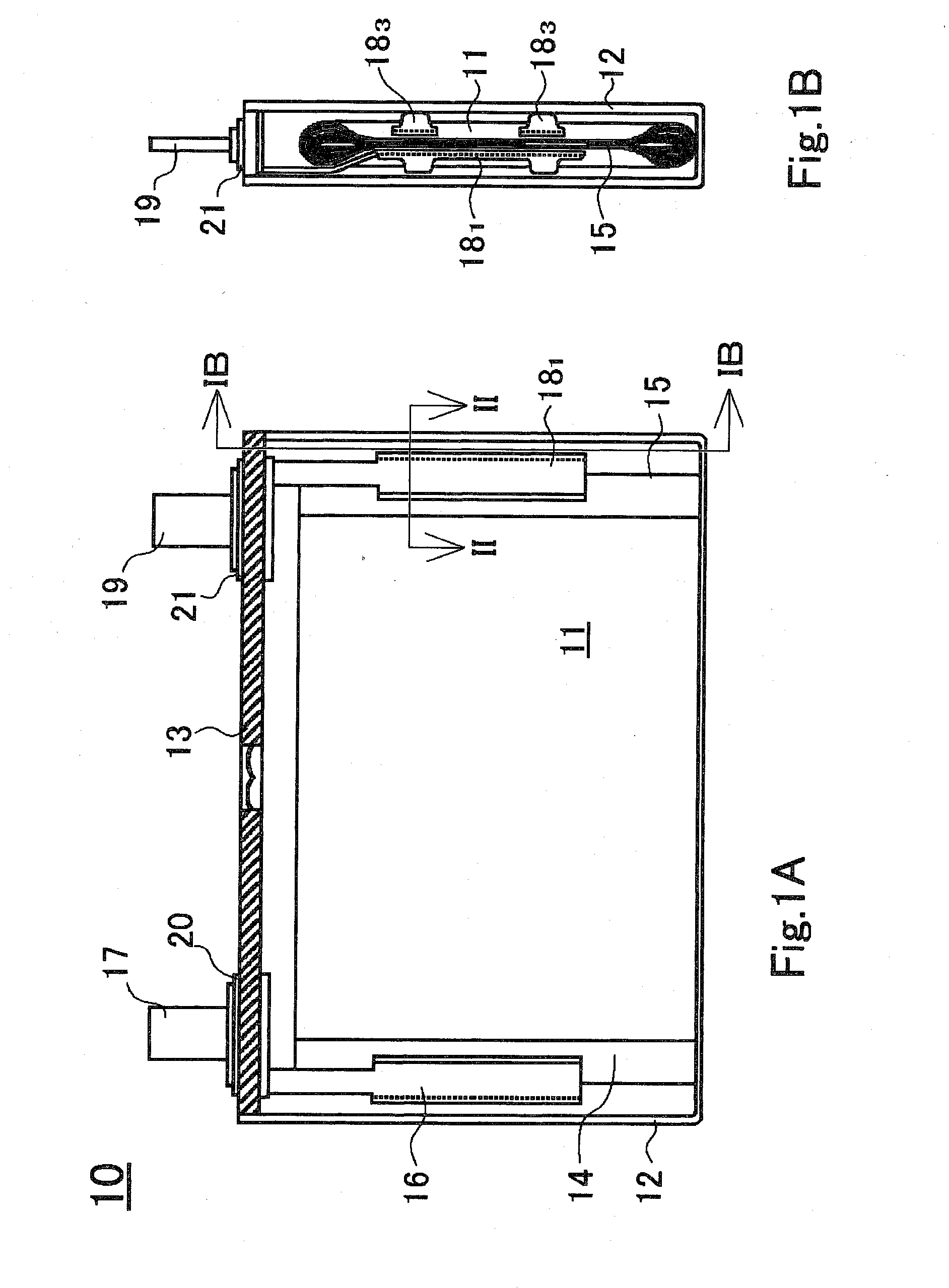Sealed battery and manufacturing method therefor
- Summary
- Abstract
- Description
- Claims
- Application Information
AI Technical Summary
Benefits of technology
Problems solved by technology
Method used
Image
Examples
first example
[0071]For the prismatic nonaqueous electrolyte secondary battery 10 of the first working example, an item was used in which a protuberance 182 (height h=0.8 mm, base portion diameter W=2 mm) acting as a projection was formed on the central portion of the negative electrode collector 181. For the insulating seal material, tape 23a (thickness L=0.1 mm) made of thermodeposited resin and with an opening 231 (circular, diameter A=6 mm) in the central portion was used. The thermodeposited resin tape 23a used consisted of multilayer film including polyolefin-based thermodeposited resin layers.
[0072]First of all, the negative electrode substrate exposed portions 15, made of copper, were bunched together, and thermodeposited resin tapes 23a were placed above and below the resulting bunch in such a manner that the centers of the openings 231 formed in the thermodeposited resin tapes 23a coincided, the bunch was disposed so that the protuberance 182 on the copper negative electrode collector 1...
second working example
[0082]In the prismatic nonaqueous electrolyte secondary battery 10 of the first working example, resistance welding was performed using a protuberance 182 formed in the central portion of the negative electrode collector 181 and an opening 231 formed in the central portion of the thermodeposited resin tape 23a, as shown in FIGS. 2 and 3. However, since the resistance welding bolt poles 241 and 242 will become hot, especially if resistance welding is performed continuously, the thermodeposited resin tape 23a itself could soften before the resistance welding current is applied. If resistance welding is performed under such conditions, the thermodeposited resin tape 23a itself could protrude out toward the weld, as shown in FIG. 5, due to the negative electrode collector 18i and negative electrode collector receiving part 183 being pushed together from both sides by the bolt poles 241 and 242 during the resistance welding. Under such conditions the thermodeposited resin could explosive...
third working example
[0087]Although thermodeposited resin tape 23a was used as the insulating seal material in the first and second working examples, it is alternatively possible to use adhesive insulating tape. The structure of a resistance weld in the prismatic battery of a third working example, which uses adhesive insulating tape 23b as the insulating seal material, will now be described using FIGS. 8 to 10. The elements in FIGS. 8 to 10 that are structurally identical to those in FIGS. 6 and 7 are assigned the identical reference numerals and detailed descriptions thereof are omitted.
[0088]The sole respect in which the structure of the weld in the third working example differs from that of the weld in the second working example is that whereas thermodeposited resin tape 23a was used as the insulating seal material in the second working example, adhesive insulating tape 23b is used in the third working example; the other structural aspects are essentially identical. For such adhesive insulating tape...
PUM
| Property | Measurement | Unit |
|---|---|---|
| Thickness | aaaaa | aaaaa |
| Diameter | aaaaa | aaaaa |
| Adhesivity | aaaaa | aaaaa |
Abstract
Description
Claims
Application Information
 Login to View More
Login to View More - R&D
- Intellectual Property
- Life Sciences
- Materials
- Tech Scout
- Unparalleled Data Quality
- Higher Quality Content
- 60% Fewer Hallucinations
Browse by: Latest US Patents, China's latest patents, Technical Efficacy Thesaurus, Application Domain, Technology Topic, Popular Technical Reports.
© 2025 PatSnap. All rights reserved.Legal|Privacy policy|Modern Slavery Act Transparency Statement|Sitemap|About US| Contact US: help@patsnap.com



